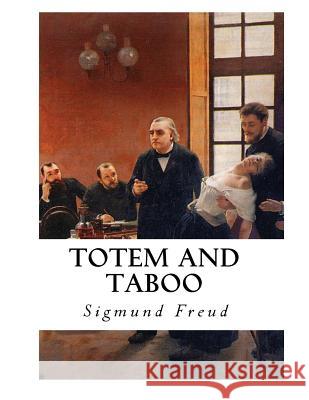Totem and Taboo: Resemblances Between the Psychic Lives of Savages and Neurotics » książka
Totem and Taboo: Resemblances Between the Psychic Lives of Savages and Neurotics
ISBN-13: 9781534820968 / Angielski / Miękka / 2016 / 86 str.
Totem and Taboo: Resemblances Between the Psychic Lives of Savages and Neurotics
ISBN-13: 9781534820968 / Angielski / Miękka / 2016 / 86 str.
(netto: 41,74 VAT: 5%)
Najniższa cena z 30 dni: 43,94
ok. 16-18 dni roboczych
Bez gwarancji dostawy przed świętami
Darmowa dostawa!
Totem and TabooResemblances Between the Psychic Lives of Savages and NeuroticsBy Prof Sigmund FreudTotem and Taboo: Resemblances Between the Mental Lives of Savages and Neurotics (German: Totem und Tabu: Einige Ubereinstimmungen im Seelenleben der Wilden und der Neurotiker) is a 1913 book by Sigmund Freud, in which Freud applies psychoanalysis to the fields of archaeology, anthropology, and the study of religion. It is a collection of four essays first published in the journal Imago (1912-13): "The Horror of Incest," "Taboo and Emotional Ambivalence," "Animism, Magic and the Omnipotence of Thoughts," and "The Return of Totemism in Childhood."WHEN one reviews the history of psychoanalysis one finds that it had its inception in the study of morbid mental states. Beginning with the observation of hysteria and the other neuroses Professor Freud gradually extended his investigations to normal psychology and evolved new concepts and new methods of study. The neurotic symptoms were no longer imaginary troubles the nature of which one could not grasp, but were conceived as mental and emotional maladjustments to one's environment. The stamp of degeneracy impressed upon neurotics by other schools of medicine was altogether eradicated. Deeper investigation showed conclusively that a person might become neurotic if subjected to certain environments, and that there was no definite dividing line between normal and abnormal. The hysterical symptoms, obsessions, doubts, phobias, as well as hallucinations of the insane, show the same mechanisms as those similar psychic structures which one constantly encounters in normal persons in the form of mistakes in talking, reading, writing, forgetting, dreams and wit. The dream, always highly valued by the populace, and as much despised by the educated classes, has a definite structure and meaning when subjected to analysis. Professor Freud's monumental work, The Interpretation of Dreams, marked a new epoch in the history of mental science. One might use the same words in reference to his profound analysis of wit.CONTENTS
- The Savage's Dread of Incest
- Taboo and the Ambivalence of Emotions
- Animism, Magic and the Omnipotence of Thought
- The Infantile Recurrence of Totemism
Zawartość książki może nie spełniać oczekiwań – reklamacje nie obejmują treści, która mogła nie być redakcyjnie ani merytorycznie opracowana.











